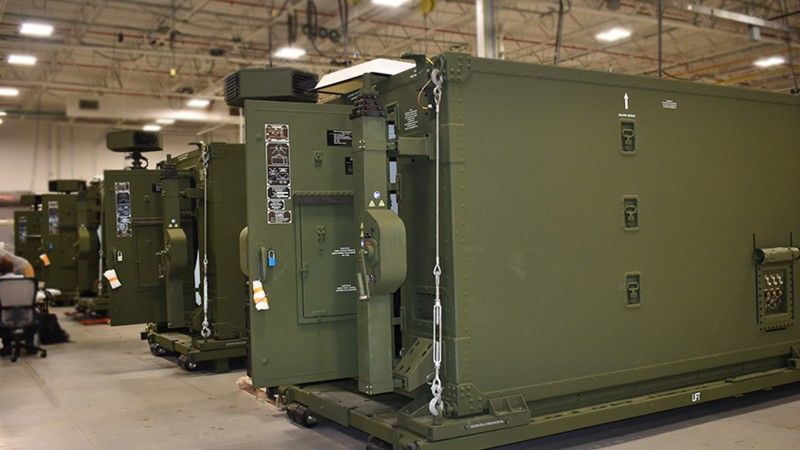IBCS is the Catalyst Modernizing Polish Air Defense

Photo. Northrop Grumman
”IBCS will become the centerpiece of the Polish Air Defense Program.” – says Bill Lamb, International Director, Northrop Grumman, in an interview with Defence24.pl. The system is currently fielded under Phase I of the medium range air defense program WISLA, and in the pending order for WISLA Phase II and for the Narew system. Polish sensors and effectors will be integrated with the Polish industry playing a key role in production. The IBCS capability is developed by Northrop Grumman for the U.S. Army, and the system is attracting interest of European and NATO allies.
Sponsored article, publishing partner Northrop Grumman
IBCS is a revolutionary command control system unifying current and future assets across the battlespace, regardless of source, service or domain. The recent months have seen a series of key events in the development of the system and its implementation both in the United States and in Poland. This year, after a number of tests and personnel training, IBCS achieved Initial Operational Capability in the United States. „This is an important milestone for the program. This means that the Army now has a capability that can be deployed in a threat situation.” – Bill Lamb, International Director, Northrop Grumman told Defence24. The U.S. Defense Department and the U.S. Army also approved the decision to move the program from Low-Rate Initial Production (LRIP) to Full Rate Production (FRP), allowing the U.S. Army to set the fielding schedule for IBCS to operational air defense units. The introduction and fielding of serially produced IBCS components to the U.S. Army for further development will start in 2024. The system configuration in the FRP variant has been modified to increase mobility. The original Integrated Fire Control Network (IFCN) relays were mounted on towed trailers, while in the serial production variant they will be directly integrated with the vehicles, resulting in a system that can be moved from one post to another faster and easier.
As part of Phase I of the Polish WISLA program, all of the equipment, including IBCS system components for the two batteries, have already been delivered, and the basic operational capability of the first battery was announced in August. Prior to that, System Integration and Checkout and soldier-operated new equipment training were performed in Poland, where the Air Defense Reconfigurable Trainer (ART) system was delivered, and where the Polish side had put in place the relevant infrastructure.
The second battery will undergo a similar process by the end of the year, and the infrastructure prepared is also used for this purpose. The next stage will be the Collaborative Training, including both batteries and a team of experts from the U.S., which will enable Polish soldiers to learn the principles of operational use for the entire squadron.
From the point of view of the Polish WISLA program, it was very important to obtain approvals from the U.S. Department of State and the U.S. Congress for the delivery of equipment for the second stage, which includes six WISLA batteries, as well as for the Narew system. The relevant approvals were issued in September 2023.

Photo. Northrop Grumman
In the second phase of WISLA, as well as in the Narew program, partnership with Polish industry will continue and an „IBCS payloads” approach will be adopted. This means Northrop Grumman will not be supplying a complete configuration similar to that of the U.S. Army, but only its selected components that will be integrated with equipment designed and manufactured by Polish industry. This is because the IBCS delivery approach is tailorable and allows for significant industrial participation and adaptation to meet Poland’s unique defense needs. „PGZ is in the process of designing three types of command centers and a Mobile Communication Center (MCC). In Phase II, the program will transition to the use of Polish command centers and communication centers,” Bill Lamb stresses. He adds the components supplied by Northrop Grumman (so-called payloads) will correspond to those manufactured for the U.S. Army and will come from the same production lines. This will ensure full interoperability. After delivery to Poland, Northrop Grumman will work with Polish industry and the Government to perform the final integration.

Photo. Mateusz Multarzyński/Defence24.pl
Integration of Polish sensors and effectors, including those intended for the Narew program, is planned for WISLA Phase II. „Integration of the Bystra radar and CAMM missile is envisioned for the second FMS contract,” - Bill Lamb emphasizes. „The Polish and U.S. Governments are working very closely, and we are supporting the finalization of the foreign military sales contract. We hope that within weeks a draft LOA (Letter of Offer and Acceptance) agreement can be presented to the Polish side for review and potential acceptance,” Bill Lamb adds.
The signing of the delivery contract will require the finalization of offset agreements, and negotiations which are currently underway. Already in Phase I Offsets of the WISLA program, Northrop Grumman executed the transfer of technology and know-how with Polish industry to provide the capability to build integration packages for the IBCS system (the so-called A-Kits).

Photo. M.Dura
Bystra and CAMM are the first sensors and effectors to be integrated into the Polish IBCS configuration, but not the only ones. Other components, such as the P-18PL and SPL pre-detection radars, which have been envisaged for IBCS from the beginning, as well as the target radar for the Narew system, Sajna, are also expected to be integrated with IBCS (and consequently into WISLA and Narew systems) after testing and acquisition by the Polish Army.
„Integration of the sensors may require simply annexing the FMS contract in the future, but it is part of the overall program,” - Bill Lamb points out. „IBCS will become the centerpiece of the Polish air defense program,” he adds. All components of the Polish IBCS (command centers and MCCs), acquired in the first and second phase of WISLA, will have the capability to control the operation of any integrated components, that is, both Patriot radars and launchers, as well as short-range missile sensors. In the future, it will be possible to integrate other components, such as the SONA system designed to provide protection for mobile Land Forces, should Poland so decide.

Photo. US Army
IBCS in the United States
It is worth looking at how the U.S. Army is developing its ability to use IBCS. Currently, the system is integrated with Patriot and Sentinel radars, which play a similar role in the U.S. system as the Bystra radars in Poland. However, the intention of the U.S. Army is to expand the use of the system, primarily in air defense. Various solutions have been tested, both within the U.S. Army and in cooperation with other military domains.
An example of the latter is the Joint Track Management Capability (JTMC), which makes it possible to exchange decision-quality fire control data between the U.S. Army’s IBCS-integrated sensors and the U.S. Navy’s systems. In 2021, a test was conducted to exchange data from the U.S. Marine Corps Ground/Air Task-Oriented Radar (G/ATOR) radar via the JTMC system. During the test, designated Flight Test 6, a PAC-3 missile launched from an IBCS-integrated Patriot launcher, in cooperation with Patriot and Sentinel radars, Air Force F-35A fighters, and precisely the G/ATOR radar connected via JTMC, successfully shot down a surrogate cruise missile while operating in an electronic attack environment.
„We have been working on JTMC technology for about two years. It is seen as an opportunity to strengthen the defense of the U.S. National Capital Region,” – says Bill Lamb. IBCS has recently been tested in Washington’s defense architecture, including interoperability with National Advanced Surface-to-Air Missile System (NASAMS). The JTMC system will also play a key role in the missile defense of Guam, where the U.S. Army will take a leading role, while interoperability with a number of Navy-owned systems is also anticipated. With the deployment of this technology, IBCS will be able to receive data from, for example, Aegis ships with SPY-1 and SPY-6 radars and E-2D Advanced Hawkeye early warning aircraft to control anti-aircraft missile fire. This will significantly enhance capabilities, including to combat cruise missiles. „JTMC is a key technology for integration with U.S. Army sensors, but within different domains, with different types of sensors.” - Bill Lamb underlines.
U.S. Army priorities for the near term include integration of the LTAMDS (Lower Tier Air and Missile Defense Sensor), the Indirect Fire Protection Capability Increment 2 (IFPC Inc 2) for short-range air defense, and the RIG-360 missile uplink device with IBCS. LTAMDS is a 360-degree radar, currently in developmental testing with the U.S. Army and intended to replace the existing Patriot radar. Twelve LTAMDS, integrated with IBCS, are part of the package purchased by Poland, the first international buyer for both systems. IBCS recently went operational with U.S. and Polish forces. The LTAMDS production for Poland is expected to commence after the U.S. Army completes an operational assessment of the new sensor.
The IFPC Inc 2 is a short-range system with a modular launcher, presently equipped with a variant of AIM-9X Sidewinder missiles. To some extent, it will play a similar role as the Polish Narew system, complementing the Patriot. Once the integration is complete, the U.S. Patriot and IFPC, along with Sentinel, LTAMDS and Patriot radars, will operate on a single network enabled by IBCS.
The U.S. Army’s next priority for IBCS integration is the RIG-360, a data link that allows information to be transmitted to PAC-3 missiles after launch, without the use of the Patriot radar, where the data link to these missiles is standard. „The RIG-360 allows for a very broad enhancement of the capabilities that Patriot has today. It gives the possibility to deploy data links at different points on the battlefield. This way we don’t tie the defense structure to the location of the Patriot radar. We can disperse the launchers and maximize the protected area and optimize the range of Patriot PAC-3 missiles.” - Bill Lamb emphasizes.

Photo. Darell Ames, PEO MS/US DoD
In November 2022, the first-ever live fire test of a PAC-3 missile using only Sentinel radars and the RIG-360 was conducted at the White Sands Missile Range in New Mexico. A surrogate cruise missile was successfully shot down after relaying the common air picture developed by IBCS based on Sentinel radar data; the Patriot radar was not used at all. The success of this test showed the ability of IBCS« architecture to remove the dependency of the Patriot radar to provide the communication link to and from the interceptor. It also further proved IBCS« ability to rapidly integrate with emerging technology.
Going forward, the U.S. Army, in the words of Bill Lamb, intends to continue integration and „to fulfill the vision of a U.S. Army Integrated Air and Missile Defense based on a single command and control system.” Consideration is therefore now being given to integrating IBCS with the Terminal High Altitude Area Defense (THAAD) system, which is deployed in Guam, for instance. The U.S. Army is also seeking integration of the IBCS with the Forward Area Air Defense Command and Control (FAAD C2) system, which is used in short range and very short range air defense missions, as well as in counter-unmanned aerial systems (C-UAS) and counter rocket, artillery and mortar (C-RAM) missions. Non-kinetic and kinetic systems, such as electronic warfare and C-UAS laser systems, are already integrated with FAAD C2.
„We have also noticed interest in integrating sensors that operate in space,” - Bill Lamb remarks. This could include, for example, integration with systems that warn of ballistic missile launches. Such integration could take place in stages, first by providing general information about the launch of an enemy missile, and then, as technology develops, by using data from space systems to create a recognized air situation picture. The ability to use data from space could be particularly important in countering hypersonic missile threats. „I think IBCS will evolve into a system that allows us to counter the full spectrum of threats, from missiles, artillery and mortar shells and UASs, to conventional aircraft and helicopters, ballistic and cruise missiles, and hypersonic missiles,” Bill Lamb insists. He points out that the U.S. military is also signaling a move toward using Air Force and Navy sensor data, as exemplified by the previously mentioned use of JTMC in Guam’s defense architecture.
In addition to the U.S. Army’s air and missile defense, which is the first and foremost user of IBCS in the U.S., it is also possible to use IBCS for „joint fires”, the direct cooperation of the U.S. Army’s air defense and rocket artillery systems. In 2022, Project Convergence demonstrated the transfer of information from IBCS to AFATDS, the U.S. Army’s field artillery tactical data system. The effort to integrate the two systems was undertaken as part of work supported by Northrop Grumman. The scenario involved the IBCS-integrated air defense system detecting the launch of a ballistic missile, determining its launch point and transmitting the coordinates to AFATDS, which was used to direct the fire of High Mobility Artillery Rocket System (HIMARS) and Multiple Launch Rocket System (MLRS) launchers. It was then possible for the U.S. Army rocket artillery to attack the ballistic missile launchers.
The solution fits into the concept of „joint fires”, and fighting ballistic missile launchers (or hostile rocket artillery systems) could reduce the use of costly interceptor missiles, such as the PAC-3 MSE. For now, however, the U.S. Army has not formally decided to commission work in this direction, although the solution is under consideration. Tests conducted so far have shown that the IBCS system has the capability to become the basis for command and control within a „joint fires” system.
Northrop Grumman also sees growing interest in the IBCS system among European and NATO countries, not least because of the growing threat from missile systems. „With the transition to Full Rate Production and the achievement of Initial Operational Capability, IBCS has reached a major milestone in the last twelve months. There is increasing interest, especially in Europe, where NATO allied countries are keeping an eye on threats, and on what Poland has done in modernizing its air and missile defense. I am optimistic about the development of the IBCS program, both in the United States and in allied countries,” Bill Lamb concluded.
Sponsored article, publishing partner Northrop Grumman



